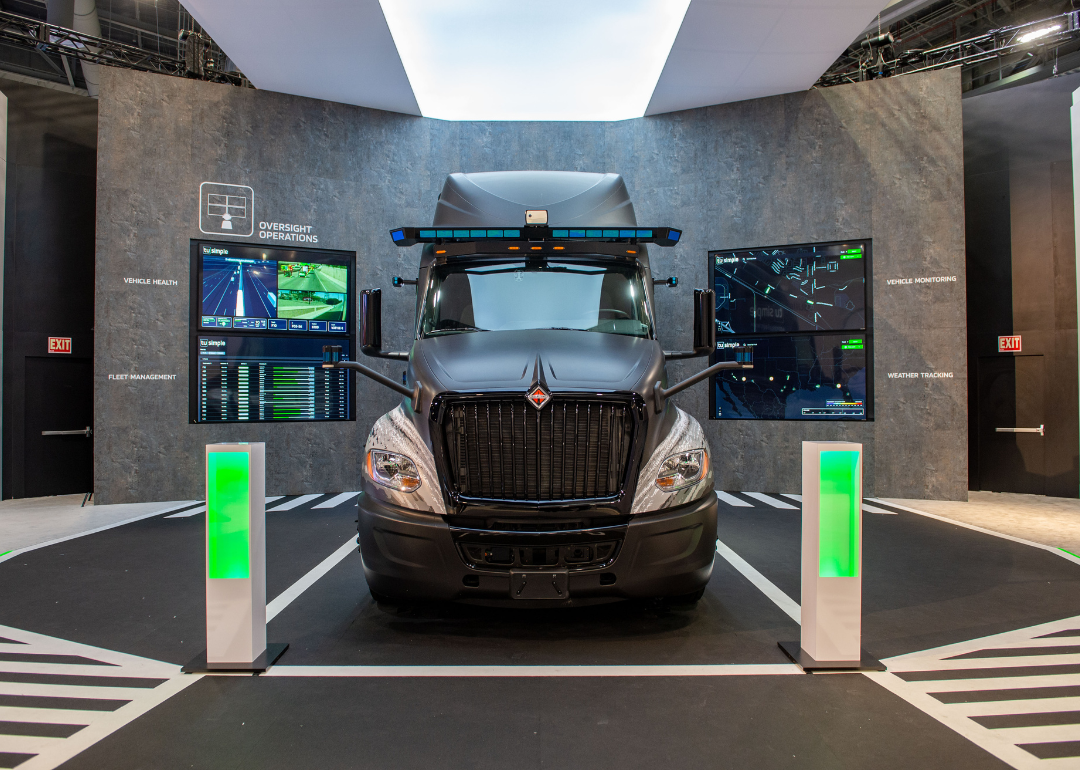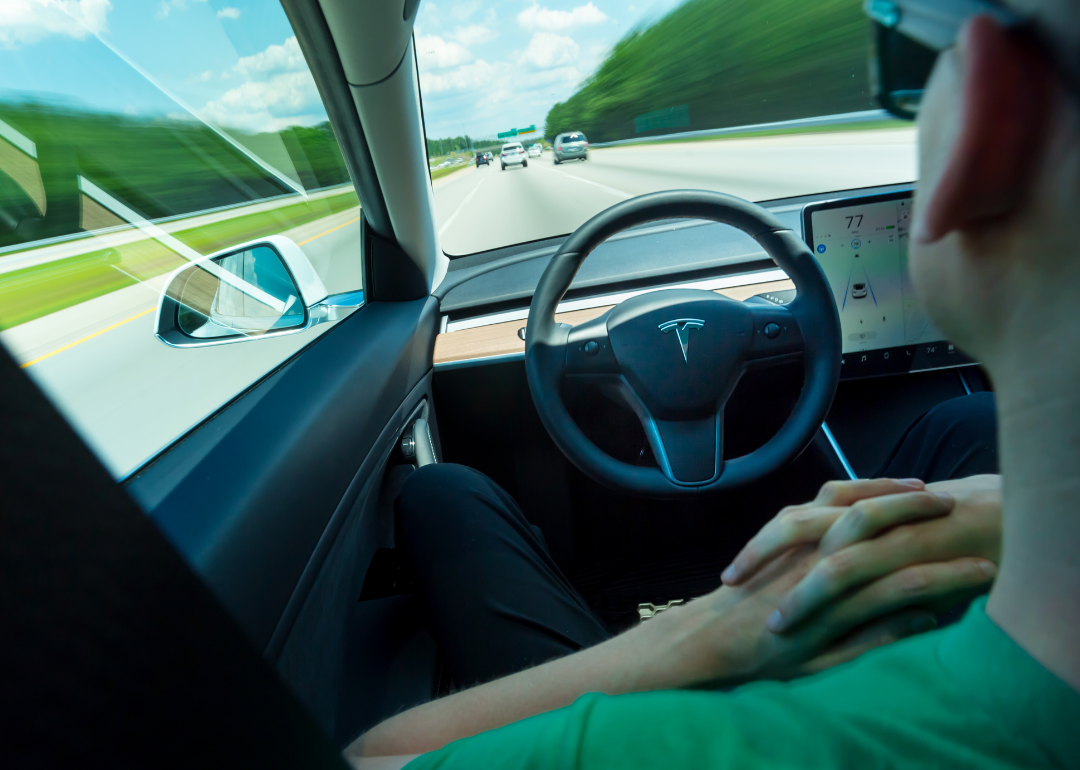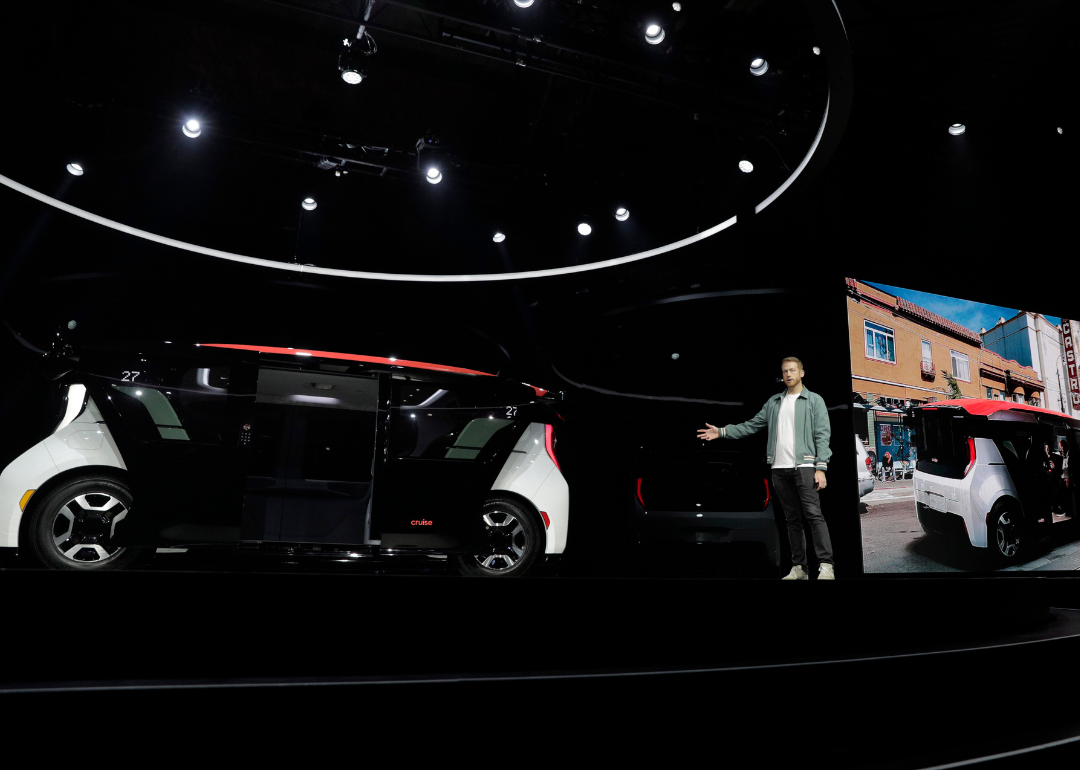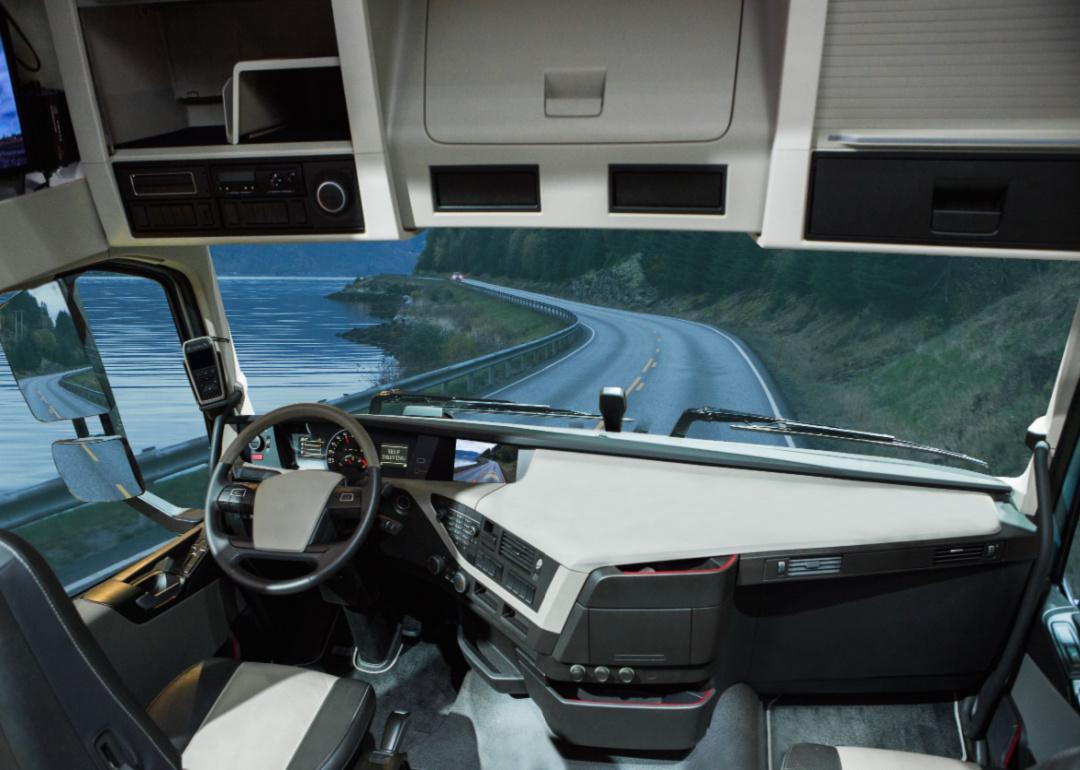Self-driving trucks, AI, and the difficulty of forecasting the future of trucking

Andrej Sokolow/picture alliance via Getty Images
Self-driving trucks, AI, and the difficulty of forecasting the future of trucking
A self-driving semi-truck on display at the CES tech show in Las Vegas.
Despite the attention on driverless cars that promise to take us to work while we snooze, the use of autonomous vehicles for large-scale freight operations has steadily gained traction over the last 20 years. Many experts believe that the first at-scale deployment of autonomous vehicle, or AV, technology will occur in freight and logistics.
Autonomous driving is a concept that isn’t easy to define—or develop. In fact, there are six different levels of autonomous driving as outlined by the Society of Automotive Engineers. These range from no automation whatsoever (level 0) to full automation (level 5), where there is no human involvement in a vehicle’s operation. The driving levels were designed as benchmarks for the incremental development of driverless technology, as well as a fairly direct method of communicating complex mechanical processes to the average person.
At present, in U.S. mainstream production, the highest level that has been achieved is level 2, which involves advanced driver assistance systems, which have become standard in most new-production consumer vehicles. Some examples of ADAS systems include parking assistance (such as a car being able to parallel park itself), proximity and pedestrian detection, and automatic braking assistance.
There have, however, been some growing pains in the development of autonomous vehicle technology, most recently involving Tesla. Several reported malfunctions and other issues associated with the automaker’s Autopilot system have led to an investigation by the National Highway Traffic Safety Administration. The company is also facing a class-action lawsuit for claiming that its Autopilot and Full-Self Driving features were fully functioning driverless technology.
While there is much promise in the future of autonomous vehicles in trucking—driverless freight vehicles are currently operating in states like California and Texas—it is also important to consider the potential impacts, both positive and negative, on the industry. Truckinfo.net gathered information from the Future of Autonomous Vehicles report, online technology resources, online freight news resources, and other sources to compile a list of key points regarding the future of automated technology in the trucking industry.
Keep reading to learn more about how automated vehicle technology may change the future of trucking.
![]()

Tunarov // Shutterstock
Defining autonomous driving and the autonomous driving levels
A hand pushing the cruise control button on a steering wheel
While the concept of autonomous driving may sound like it’s one thing—a vehicle that can drive on its own without a human driver’s input—the reality is that there isn’t just one type of self-driving vehicle, nor is there one type of autonomous driving. Rather, there are a variety of automation levels that determine what the degree of autonomous operation a vehicle is capable of.
The six autonomous driving levels as defined by the Society of Automotive Engineers are as follows: level 0 offers no driver assistance; level 1 offers driver assistance through a single feature, such as cruise control; level 2 employs ADAS systems; level 3 provides conditional automation by which the vehicle can perform most driving tasks but still requires human override; at level 4 the vehicle performs all driving operations under specific circumstances, though environmental infrastructure such as geofencing is required; and finally, level 5 is full automation where the vehicle is in complete control with zero human action necessary.
Level 1 automation has actually existed since the 1940s, when cruise control was introduced. The vehicles being test-operated in California and Texas are at level 2 automation, which requires a rotating team of human operators to be present and alert at all times.

TierneyMJ // Shutterstock
From self-steering to false claims of autonomy, the history of robot cars is full of turbulence
A person using the autopilot self-driving function in an all electric Tesla Model 3
The concept of the driverless vehicle dates back nearly 100 years and is not simply the product of a science-fiction conceit. At the 1939 World’s Fair, General Motors’ Futurama exhibit envisioned the America of 1960—and that vision contained self-driving cars. Progress toward automation was, in some regards, swift. The invention of cruise control in 1945 put postwar society on what is now the AV spectrum. By the 1960s and ’70s, remote-controlled cars were being tested in the U.S. and Japan.
In 1987, the Eureka Prometheus project was launched in Europe, and seven years later robotic cars that were part of the project were capable of driving 1,000 kilometers. The 21st century has seen even more rapid progress, with benchmarks such as Google’s completion of 500,000 autonomous driving miles in 2000, the founding of Tesla Motors in 2003, and Volvo’s launching of the Drive Me project in Sweden in 2016, demonstrating the large-scale investment companies are now willing to make to develop autonomous driving technologies.
Not all has been sunny. Despite the fact that Tesla is the top-selling electric vehicle in the U.S. and has one of the most advanced ADAS systems in commercial production, the promotion of its Autopilot system has gotten the company into some very hot water with consumers. A 2022 class action lawsuit filed in California accused Tesla of misleading the public when it came to its “Full Self-Driving” technology.
According to a press release from the law firm that filed the suit, Tesla has been misleading the public “since at least 2016” through marketing materials that made it seem as though the company’s driver-assist technology was already fully or nearly autonomously functional. A marketing video released by Tesla that showed a vehicle driving itself turned out to have been doctored; it failed to show all of what had been filmed, including when the vehicle crashed into a barrier. The lawsuit has triggered National Transportation Safety Board and National Highway Traffic Safety Administration investigations, as well as investigations by other regulators.
In July 2022, the California Department of Motor Vehicles filed a motion against Tesla for making misleading statements about its Autopilot and Full Self-Driving features. The complaint seeks to suspend or revoke the automaker’s dealer and manufacturing licenses, as well as possible restitution.

San Francisco Chronicle/Hearst Newspapers // Getty Images
Current sentiment towards vehicle autonomy is mixed after many delayed deployment dates
Kyle Vogt showing off the new Cruise vehicle at the unveiling of the Cruise Origin, an autonomous passenger vehicle
The Future of Autonomous Vehicles report cited a marked change in the stance taken by a variety of key influencers in the AV space with regard to deployment speed between 2018 and 2019, the year by which many in the industry initially believed AV technology would be production-ready. While confidence still remains that the overall direction of development is sound, uncertainty is greater when it comes to how quickly widespread impact will occur and how to get to the point where autonomous driving is readily available for the consumer marketplace.
An updated timeframe for deployment remains murky. A 2022 report estimates that the commercialization of driverless cars will likely not happen before 2030—and that date may even be unrealistically optimistic. While AV startups have raised billions of dollars to develop new technologies, skepticism remains with certain major automakers as to the ultimate value of taking the human driver out of the equation altogether.
Speaking with Reuters in Sept. 2022, Kyle Vogt, CEO of General Motors’ AV development artery Cruise, flat-out questioned why human oversight should ever be removed. “I can provide my customers peace of mind knowing there is always a human there to help if needed,” Vogt said. “I don’t know why I’d ever want to get rid of that.” Earlier that month, Cruise recalled 80 self-driving vehicles in order to revise their software following a crash that left two people injured.

Andrej Sokolow/picture alliance via Getty Images
Freight has emerged as a possible leading industry for the use of autonomous vehicles
A self-driving semi-truck at the CES tech show in Las Vegas
The first autonomous truck journey in history was a beer run. In 2016, a self-driving Otto truck, without a human driver in the cab, drove 120 miles down I-25 in Colorado and safely delivered more than 51,000 cans of Budweiser. The truck received assistance from a professional driver only to enter and exit the highway—during the long haul, it operated entirely on its own.
Currently, autonomous trucking doesn’t yet mean that there are trucks out bombing down the road with no driver in sight; instead, trucks are equipped with ADAS systems that include self-driving features such as automated gear shifting, cruise control, radar, and power steering. Drivers still have to remain in the cabin and know how to use the technology in order to take control in the case of emergency or malfunction.
The presence of these autonomous trucks on the road is expected to increase in the coming decade as further testing is completed. In fact, the development of AV tech for freight trucks is looking like it will outpace that of passenger vehicles. Autonomous freight truck solutions provider TuSimple expects its autonomous freight-truck technology to be operational by 2024. The company recently went public and plans to use the infusion of cash its public offering has provided to take its current level 4 tech up to level 5 full autonomy. More than 5,700 vehicles have already been put on order from the company by shippers and carriers.
While all AVs will have to operate within existing infrastructure, it is believed that freight hauling is the most likely means of seeing new tech hit the road early, not only because the trucking industry has a significant commercial interest in implementing it but also because of how autonomous technology interacts with the surrounding environment.
Many ADAS systems employ a combination of sonar and radar technology to detect the proximity of other vehicles on the road, as well as pedestrians, bicyclists, and stationary objects near the roadway such as jersey barriers. Autonomous technology uses lidar, which creates a three-dimensional model of the surrounding environment, taking into account each and every object within its scope with laser precision. Lidar mapping is a constant send-and-receive process of millions of light pulses per second.
Because the amount of information an AV will need to send, receive, process, and maintain in real-time is so incredibly complex, more widespread adoption will likely begin in freight hauling simply because most of these vehicles’ driving environments tend to be “simpler” than those of the average passenger vehicle—multilane highways with consistent lane widths and clear striping, few if any pedestrians, and readily identifiable ingress and egress points, as opposed to the relative urban or suburban traffic navigated by your average errand-running sedan.
This technology could also mean much shorter long-haul journey times, which will result in significant time-dollar savings, as well as improved fuel economy. Several truck manufacturers and startups—including Volvo, Traton Group, PACCAR, Daimler, PlusAI, and Embark Trucks—have all started to get involved in the automation of trucks.

Scharfsinn // Shutterstock
The future impacts of self-driving trucks are uncertain
Interior perspective of a self-driving truck on the road with no driver
Trade-offs in job losses versus job gains related to automation are hard to predict. Over time, automation tends to create as many jobs as it takes away—though the jobs it creates can be significantly different from the ones that it replaces. When workers use machines, they’re able to produce more of a product in the same amount of time and usually for a lower cost. The additional supply and affordability of the product usually lead to consumers buying more of it, which can lead to the creation of more new jobs; however, workers that do by hand what machines do automatically can end up replaced by them.
In the trucking sector, it is not as simple as self-driving trucks cutting out the jobs of truck drivers, though the introduction of self-operating freight vehicles would have an effect on the number of trucking jobs available and, perhaps more importantly, the number of hours available to those workers.
A March 2022 study published in Humanities and Social Sciences Communications looked at what the possible effect would be on driver hours from the assimilation of AVs on long-haul portions of freight routes. The study considered the transfer-hub model, which has been suggested by supporters of AV integration as a solution to concerns over a diminishment in truck operator employment levels. The model is set on the idea that “operationally less complex highway driving is automated, while human drivers drive the more complex urban segment of the route.” Researchers concluded that with nationwide adoption, 94% of all long-haul operator hours would be impacted. Plus, the suggestion that a greater number of short-haul hours could make up for the long-haul hours lost due to a significant increase in overall shipping volume was unlikely.
The American Trucking Associations reported an operator shortage of 80,000—a number that could climb to 160,000 by the decade’s end. This fact shades concerns that AV trucks could eventually make certain jobs obsolete in the industry, namely those of driver-operators. But even with on-road testing of autonomous trucking technology accelerating ahead of that in commercial passenger vehicles, the road toward ubiquity is a long one, and trained driver-operators will be a necessary part of freight and logistics for the foreseeable future—so much so that the ATA’s recommendation for the nationwide driver shortage is not bigger investment in new tech, but the hiring of 1 million operators over the next decade.
The Future of Autonomous Vehicles report makes a crucial point that would seem to buoy the ATA’s position. AVs will be expensive, initially at least, and their implementation will only be viable if there is high utilization—which means both the technology and the surrounding infrastructure must be ready for them. With the U.S. facing a $786 billion road and bridge capital needs backlog in order to achieve a nationwide state of good repair, it would seem that, regardless of advances in technology, there is as yet no substitute for the well-trained driver-operator.
This story originally appeared on Truckinfo.net and was produced and
distributed in partnership with Stacker Studio.





